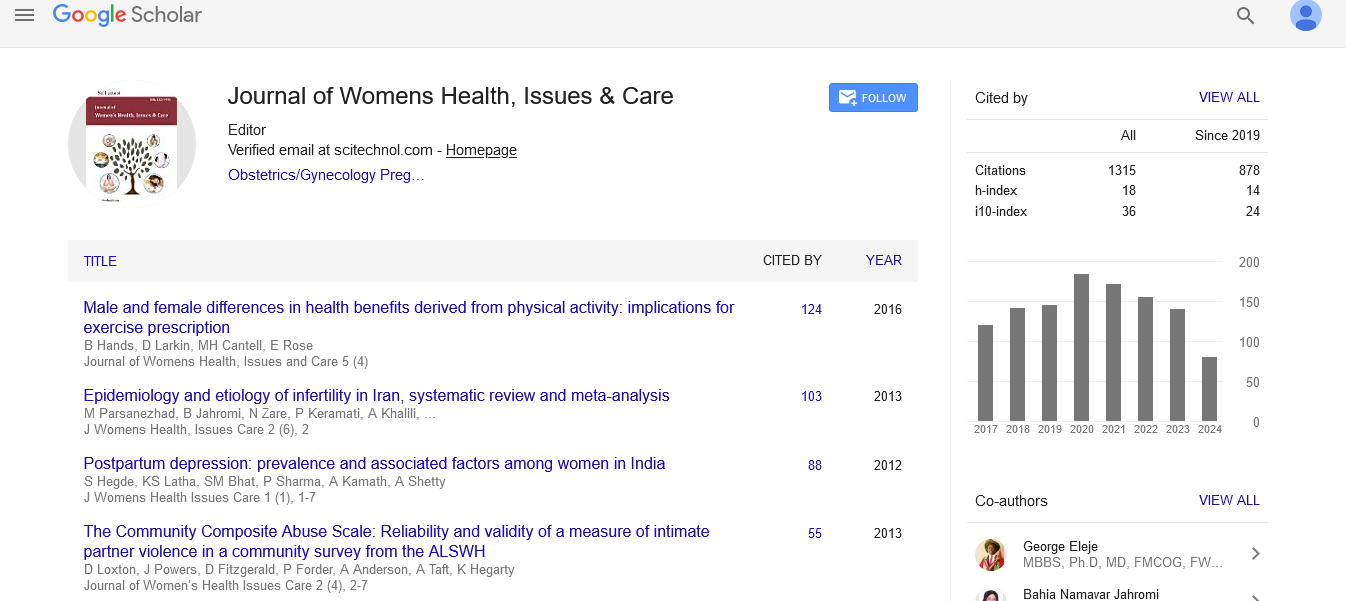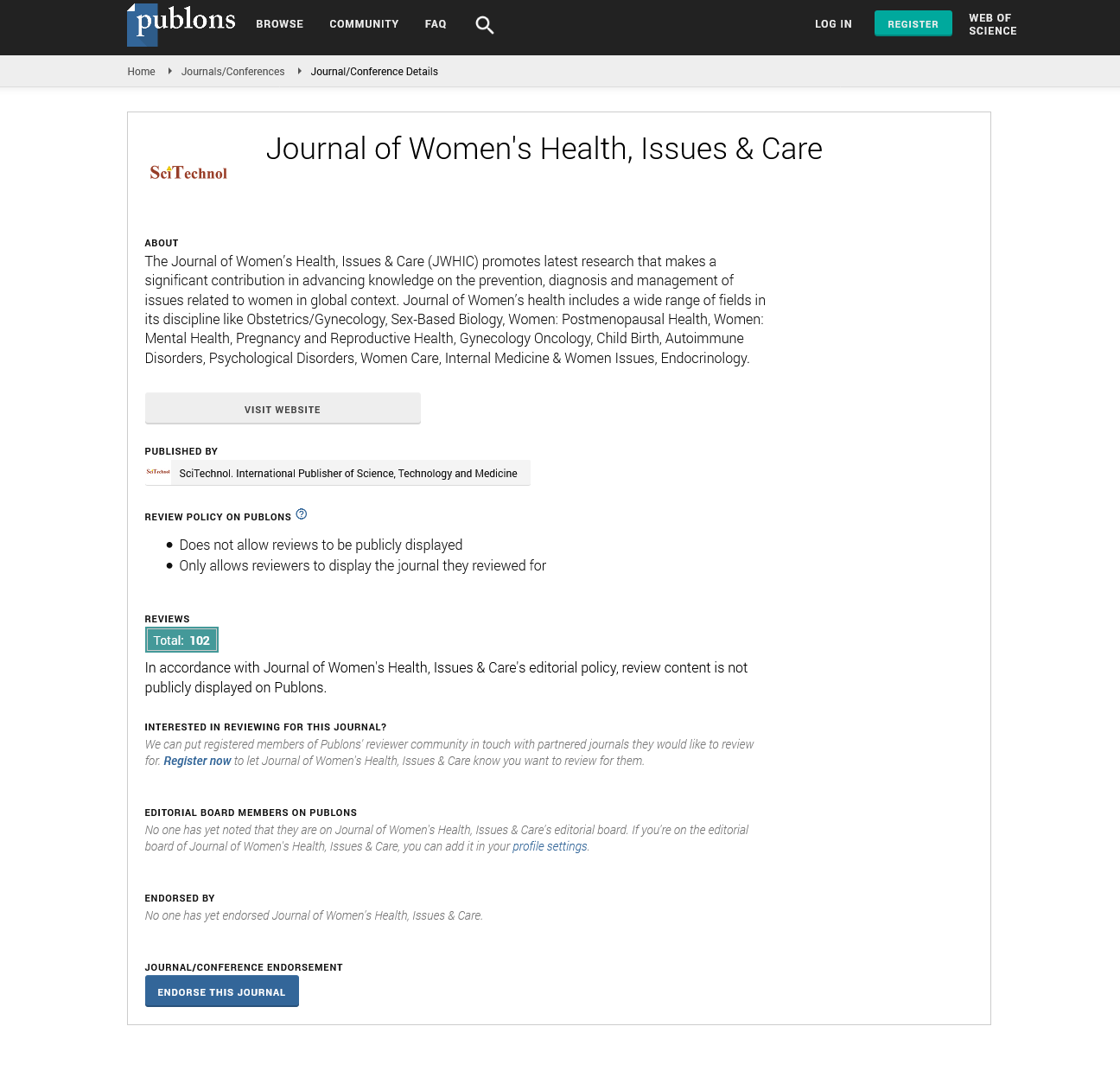Perspective, J Womens Health Vol: 13 Issue: 2
Exploring Factors, Causes and Treatments for Fertility Concerns in Women
Martin Inoue*
1Department of Surgery and Comprehensive Cancer Centre, Medical University of Vienna, Vienna, Austria
*Corresponding Author: Martin Inoue,
Department of Surgery and
Comprehensive Cancer Centre, Medical University of Vienna, Vienna, Austria
E-mail: Martin.inoue@uni.edu
Received date: 27 March, 2024, Manuscript No. JWHIC-24-132535;
Editor assigned date: 29 March, 2024, PreQC No. JWHIC-24-132535 (PQ);
Reviewed date: 12 April, 2024, QC No. JWHIC-24-132535;
Revised date: 19 April, 2024, Manuscript No. JWHIC-24-132535 (R);
Published date: 29 April, 2024 DOI: 10.4172/2325-9795.1000494.
Citation: Inoue M (2024) Exploring Factors, Causes and Treatments for Fertility Concerns in Women. J Womens Health 13:2.
Description
Fertility is a fundamental aspect of women's health and well-being, yet many women encounter challenges when trying to conceive. Fertility issues can arise from a variety of factors, including reproductive disorders, hormonal imbalances, age-related changes, and lifestyle factors.
Factors influencing fertility
Fertility is influenced by a myriad of factors, both physiological and environmental. Age is a critical determinant of fertility, with a decline in fertility observed as women age, particularly after the age of 35. Reproductive disorders such as Polycystic Ovary Syndrome (PCOS), endometriosis, and diminished ovarian reserve can impair fertility. Hormonal imbalances, including irregular menstrual cycles and thyroid disorders, can also affect fertility. Lifestyle factors such as smoking, excessive alcohol consumption, obesity, and stress can further exacerbate fertility issues.
Common causes of infertility
Infertility is defined as the inability to conceive after one year of regular unprotected intercourse for women under 35 years of age, or after six months for women over 35. Common causes of infertility in women include ovulatory disorders, tubal factors, uterine abnormalities, and diminished ovarian reserve. Ovulatory disorders, such as irregular or absent ovulation, account for a significant proportion of infertility cases. Tubal factors, including blockages or damage to the fallopian tubes, can prevent the egg from reaching the uterus for fertilization. Uterine abnormalities such as fibroids or polyps can interfere with implantation, while diminished ovarian reserve refers to a decline in the quantity and quality of eggs.
Diagnostic approaches to fertility issues
Diagnosing fertility issues often involves a comprehensive evaluation of both partners' reproductive health. For women, diagnostic tests may include hormone testing to assess ovarian function, imaging studies such as transvaginal ultrasound to evaluate the uterus and ovaries, and Hysterosalpingography (HSG) to assess tubal patency. Additional tests, such as laparoscopy, may be performed to further evaluate pelvic anatomy. Male partners may undergo semen analysis to assess sperm count, motility, and morphology. Comprehensive diagnostic evaluation is essential for identifying the underlying causes of infertility and guiding appropriate treatment strategies.
Treatment options for fertility issues
Treatment options for fertility issues vary depending on the underlying cause and individual circumstances. Ovulation induction, often using medications such as clomiphene citrate or letrozole, may be recommended for women with ovulatory disorders. Assisted Reproductive Technologies (ART), including Intrauterine Insemination (IUI) may be considered for couples with tubal factors, male factor infertility, or unexplained infertility. Surgical interventions, such as laparoscopic surgery for endometriosis or tubal repair, may be indicated in certain cases. Lifestyle modifications, including weight loss, smoking cessation, and stress reduction techniques, can also improve fertility outcomes.
Conclusion
Fertility issues affect millions of women worldwide, posing emotional, physical, and financial challenges. Understanding the factors influencing fertility, common causes of infertility, diagnostic approaches, and treatment options is essential for supporting women on their journey to parenthood. By enhancing awareness and access to fertility care, healthcare providers can empower women to make informed decisions and navigate their fertility journey with confidence. Further research is needed to advance our understanding of fertility issues and develop innovative interventions to improve fertility outcomes for women globally.
 Spanish
Spanish  Chinese
Chinese  Russian
Russian  German
German  French
French  Japanese
Japanese  Portuguese
Portuguese  Hindi
Hindi 



